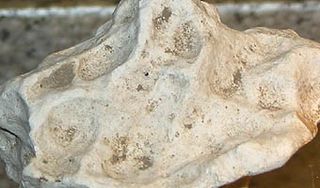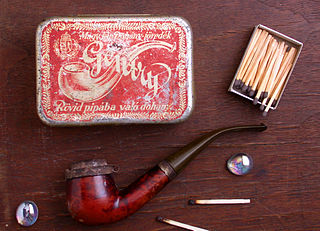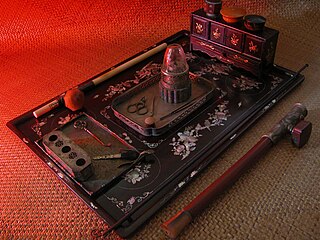
A tobacco pipe, often called simply a pipe, is a device specifically made to smoke tobacco. It comprises a chamber for the tobacco from which a thin hollow stem (shank) emerges, ending in a mouthpiece. Pipes can range from very simple machine-made briar models to highly prized hand-made artisanal implements made by renowned pipemakers, which are often very expensive collector's items.

Smoking is the process of flavoring, browning, cooking, or preserving food, particularly meat, fish and tea, by exposing it to smoke from burning or smoldering material, most often wood.

A head shop is a retail outlet specializing in paraphernalia used for consumption of cannabis and tobacco and items related to cannabis culture and related countercultures. They emerged from the hippie counterculture in the late 1960s, and at that time, many of them had close ties to the anti-Vietnam War movement as well as groups in the marijuana legalization movement like LeMar, Amorphia, and the National Organization for the Reform of Marijuana Laws.

A chipotle, or chilpotle, is a smoke-dried ripe jalapeño chili pepper used for seasoning. It is a chili used primarily in Mexican and Mexican-inspired cuisines, such as Tex-Mex and Southwestern United States dishes. It comes in different forms, such as chipotles en adobo.

Calabash, also known as bottle gourd, white-flowered gourd, long melon, birdhouse gourd, New Guinea bean, New Guinea butter bean, Tasmania bean, and opo squash, is a vine grown for its fruit. It can be either harvested young to be consumed as a vegetable, or harvested mature to be dried and used as a utensil, container, or a musical instrument. When it is fresh, the fruit has a light green smooth skin and white flesh.

A chillum, or chilam, is a straight conical smoking pipe traditionally made of either clay or a soft stone. It was used popularly in India in the eighteenth century and still often used to smoke marijuana. A small stone is often used as a stopper in the stem. The style of pipe spread to Africa, and has been known in the Americas since the 1960s. A chillum pipe is used in Rastafari rituals.

A chibouk is a very long-stemmed Turkish tobacco pipe, often featuring a clay bowl ornamented with precious stones. The stem of the chibouk generally ranges between 4 and 5 ft., much longer than even Western churchwarden pipes. While primarily known as a Turkish pipe, the chibouk was once popular across the Ottoman Empire and in Iran as well.

Pipe smoking is the practice of tasting the smoke produced by burning a substance, most commonly tobacco or cannabis, in a pipe. It is the oldest traditional form of smoking.
Pipe Smoker of the Year was an award given out annually by the British Pipesmokers' Council, to honour a famous pipe-smoking individual. Initiated in 1965 as Pipeman of the Year by the Briar Pipe Trade Association, it was presented at a lunch in London's Savoy Hotel each January. The award was discontinued in 2004 because its organisers feared it fell foul of laws banning all advertising and promotion of tobacco.

Sepiolite, also known in English by the German name meerschaum ( MEER-shawm, -shəm; German:[ˈmeːɐ̯ʃaʊm] ; meaning "sea foam"), is a soft white clay mineral, often used to make tobacco pipes (known as meerschaum pipes). A complex magnesium silicate, a typical chemical formula for which is Mg4Si6O15(OH)2·6H2O, it can be present in fibrous, fine-particulate, and solid forms.

Peterson is an Irish pipe maker headquartered in Dublin and founded in 1865.
Stomatitis nicotina is a diffuse white patch on the hard palate, usually caused by tobacco smoking, usually pipe or cigar smoking. It is painless, and it is caused by a response of the palatal oral mucosa to chronic heat. A more pronounced appearance can occur with reverse smoking, sometimes distinguished from stomatitis nicotina by the term reverse smoker's stomatitis. While stomatitis nicotina that is caused by heat is not a premalignant condition, the condition that is caused by reverse smoking is premalignant.

Dottle is the remaining plug of unburnt tobacco and ashes left in the bottom of a tobacco pipe when it has been smoked.

A smoking pipe is used to taste the smoke of a burning substance; most common is a tobacco pipe. Pipes are commonly made from briar, heather, corncob, meerschaum, clay, cherry, glass, porcelain, ebonite and acrylic.

An opium pipe is a pipe designed for the evaporation and inhalation of opium. True opium pipes allow for the opiate to be vaporized while being heated over a special oil lamp known as an opium lamp. It is thought that this manner of "smoking" opium began in the seventeenth century when a special pipe was developed that vaporized opium instead of burning it.

Smoking is a practice in which a substance is combusted and the resulting smoke is typically inhaled to be tasted and absorbed into the bloodstream of a person. Most commonly, the substance used is the dried leaves of the tobacco plant, which have been rolled with a small rectangle of paper into an elongated cylinder called a cigarette. Other forms of smoking include the use of a smoking pipe or a bong.
Swan Vestas is a brand of matches. Shorter than normal pocket matches, they are particularly popular with smokers and have long used the tagline "the smoker's match", although this has been replaced by the prefix "the original" on the current packaging. Until 2018 they were "strike-anywhere" matches, but in response to a change in EU regulations banning the necessary chemicals Swan Vestas were changed to be safety matches.

The history of smoking dates back to as early as 5000 BC in the Americas in shamanistic rituals. With the arrival of the Europeans in the 16th century, the consumption, cultivation, and trading of tobacco quickly spread. The modernization of farming equipment and manufacturing increased the availability of cigarettes following the reconstruction era in the United States. Mass production quickly expanded the scope of consumption, which grew until the scientific controversies of the 1960s, and condemnation in the 1980s.

The Amsterdam Pipe Museum is a museum in Amsterdam, the Netherlands, dedicated to smoking pipes, tobacco, and related paraphernalia. It holds the national reference collection in these areas.
Inqawe is the Xhosa term for the traditional smoking pipe used among the Xhosa people. The pipes come in many variations but are mostly made from Acacia afra or ‘mnyamanzi’ which is commonly found in the Eastern Cape. Xhosa men and women carry a pipe in a beaded tobacco bag called ‘inxili’ as part of their traditional attire when they attend rituals and traditional functions.



















